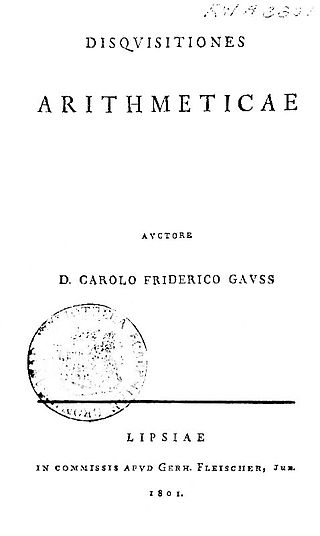In number theory, the Legendre symbol is a multiplicative function with values 1, −1, 0 that is a quadratic character modulo of an odd prime number p: its value at a (nonzero) quadratic residue mod p is 1 and at a non-quadratic residue (non-residue) is −1. Its value at zero is 0.

In number theory, the law of quadratic reciprocity is a theorem about modular arithmetic that gives conditions for the solvability of quadratic equations modulo prime numbers. Due to its subtlety, it has many formulations, but the most standard statement is:
RSA (Rivest–Shamir–Adleman) is a public-key cryptosystem, one of the oldest widely used for secure data transmission. The initialism "RSA" comes from the surnames of Ron Rivest, Adi Shamir and Leonard Adleman, who publicly described the algorithm in 1977. An equivalent system was developed secretly in 1973 at Government Communications Headquarters (GCHQ), the British signals intelligence agency, by the English mathematician Clifford Cocks. That system was declassified in 1997.

The Jacobi symbol is a generalization of the Legendre symbol. Introduced by Jacobi in 1837, it is of theoretical interest in modular arithmetic and other branches of number theory, but its main use is in computational number theory, especially primality testing and integer factorization; these in turn are important in cryptography.
In number theory, Euler's criterion is a formula for determining whether an integer is a quadratic residue modulo a prime. Precisely,
In mathematics, the Lucas–Lehmer test (LLT) is a primality test for Mersenne numbers. The test was originally developed by Édouard Lucas in 1878 and subsequently proved by Derrick Henry Lehmer in 1930.
Identity-based encryption (IBE), is an important primitive of identity-based cryptography. As such it is a type of public-key encryption in which the public key of a user is some unique information about the identity of the user. This means that a sender who has access to the public parameters of the system can encrypt a message using e.g. the text-value of the receiver's name or email address as a key. The receiver obtains its decryption key from a central authority, which needs to be trusted as it generates secret keys for every user.
The Rabin cryptosystem is a family of public-key encryption schemes based on a trapdoor function whose security, like that of RSA, is related to the difficulty of integer factorization.
The Paillier cryptosystem, invented by and named after Pascal Paillier in 1999, is a probabilistic asymmetric algorithm for public key cryptography. The problem of computing n-th residue classes is believed to be computationally difficult. The decisional composite residuosity assumption is the intractability hypothesis upon which this cryptosystem is based.
In number theory, quadratic Gauss sums are certain finite sums of roots of unity. A quadratic Gauss sum can be interpreted as a linear combination of the values of the complex exponential function with coefficients given by a quadratic character; for a general character, one obtains a more general Gauss sum. These objects are named after Carl Friedrich Gauss, who studied them extensively and applied them to quadratic, cubic, and biquadratic reciprocity laws.
In number theory, the Kronecker symbol, written as or , is a generalization of the Jacobi symbol to all integers . It was introduced by Leopold Kronecker.
Gauss's lemma in number theory gives a condition for an integer to be a quadratic residue. Although it is not useful computationally, it has theoretical significance, being involved in some proofs of quadratic reciprocity.
The Goldwasser–Micali (GM) cryptosystem is an asymmetric key encryption algorithm developed by Shafi Goldwasser and Silvio Micali in 1982. GM has the distinction of being the first probabilistic public-key encryption scheme which is provably secure under standard cryptographic assumptions. However, it is not an efficient cryptosystem, as ciphertexts may be several hundred times larger than the initial plaintext. To prove the security properties of the cryptosystem, Goldwasser and Micali proposed the widely used definition of semantic security.
In number theory, the law of quadratic reciprocity, like the Pythagorean theorem, has lent itself to an unusually large number of proofs. Several hundred proofs of the law of quadratic reciprocity have been published.
The Blum–Goldwasser (BG) cryptosystem is an asymmetric key encryption algorithm proposed by Manuel Blum and Shafi Goldwasser in 1984. Blum–Goldwasser is a probabilistic, semantically secure cryptosystem with a constant-size ciphertext expansion. The encryption algorithm implements an XOR-based stream cipher using the Blum-Blum-Shub (BBS) pseudo-random number generator to generate the keystream. Decryption is accomplished by manipulating the final state of the BBS generator using the private key, in order to find the initial seed and reconstruct the keystream.
The Tonelli–Shanks algorithm is used in modular arithmetic to solve for r in a congruence of the form r2 ≡ n, where p is a prime: that is, to find a square root of n modulo p.
The Boneh–Franklin scheme is an identity-based encryption system proposed by Dan Boneh and Matthew K. Franklin in 2001. This article refers to the protocol version called BasicIdent. It is an application of pairings over elliptic curves and finite fields.
Quartic or biquadratic reciprocity is a collection of theorems in elementary and algebraic number theory that state conditions under which the congruence x4 ≡ p is solvable; the word "reciprocity" comes from the form of some of these theorems, in that they relate the solvability of the congruence x4 ≡ p to that of x4 ≡ q.
Pocklington's algorithm is a technique for solving a congruence of the form
Coppersmith's attack describes a class of cryptographic attacks on the public-key cryptosystem RSA based on the Coppersmith method. Particular applications of the Coppersmith method for attacking RSA include cases when the public exponent e is small or when partial knowledge of a prime factor of the secret key is available.








































